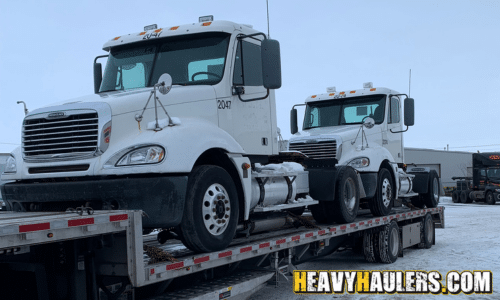Heavy haulers understand that many factors affect the ability to move loads from one point to another. For example, when there is ice and snow in the winter, delivering your cargo on schedule can be a challenge. Reduced tire traction, poor visibility and the impact of extremely cold temperatures on the team and drivers are common challenges faced by drivers and support staff. Understanding and complying with winter road restrictions is vital to smooth heavy haulage operations. In this article, we’ll explore common winter road restrictions, plan for those restrictions, and the importance of compliance during winter transportation.
Common restrictions in winter
In addition to knowing some safe winter driving tricks, drivers should be aware of common winter road restrictions for trouble-free heavy haul operations. It is important to note that each state has its own specific winter road restrictions. Therefore, it is essential to understand the specific regulations of the states you will pass through when transporting your cargo. Common load restrictions to consider include:
Weight limits on icy roads
In winter, a common road restriction is to reduce weight limits when driving on icy or snowy roads. These restrictions ensure the safety of the driver and all passengers and prevent damage to the road surface. Before you embark on transporting heavy equipment in the winter, you need to understand the weight limits on icy roads to avoid unnecessary incidents and fines.
Restricted routes during snowfall
During winter storms or heavy snowfall, specific routes may be restricted or temporarily closed to ensure the safety of travelers. Awareness of these restrictions will help drivers and other transport agents plan alternative routes to minimize delays and disruptions.
Time-based restrictions for safer travel
Winter road restrictions include weather-based restrictions, such as prohibiting drivers from driving at night or in adverse weather conditions. These restrictions aim to reduce the risk of accidents and ensure that heavy transport operations are carried out in the safest possible conditions. It is vital to stay updated on real-time weather conditions and these restrictions and plan accordingly.

Planning around winter road restrictions
Knowing what to expect during the winter season and planning will help drivers and other transportation agents avoid delays and unexpected incidents. Here are ways drivers can prepare for and stay safe in the face of winter road restrictions:
Using real-time road condition updates
With advances in technology, drivers and other logistics experts can access real-time updates on road conditions through a variety of credible sources, including government websites, weather apps, and GPS systems. Knowing certain weight limits, road closures and weather forecasts can help drivers plan alternate routes and schedules as needed.
Planning alternative itineraries
Reliable heavy haulage companies should always have contingency plans for winter heavy haulage. This includes identifying alternative routes less affected by extreme cold temperatures and weather-related restrictions. A well-thought-out backup plan can help minimize delays and ensure that winter transportation operations run smoothly.
Coordination with local authorities
Keeping open lines of communication and coordination with local authorities is vital during winter transportation. Local authorities provide critical updates on winter road restrictions and essential weather updates. They also grant the necessary heavy transport permits or exemptions where necessary.
Weather forecasting tools
When planning heavy snow transport, use reliable weather forecasting services to access real-time information about weather conditions, especially about the planned route, pickup and destination location. Other vital tools are Road Weather Information Systems (RWIS) used by various states and regions to provide data on:
- Road surface conditions
- Air temperature
- precipitation
- Expected snowfall and more
Traffic monitoring systems
These systems provide real-time updates on traffic and road conditions, including road closures, accidents, slowdowns and heavy snowfall. The systems help ensure that heavy equipment shipments arrive safely and on time by choosing the most appropriate route.
Benefits of strategic planning of heavy transport routes in winter
Strategic winter route planning offers several benefits that streamline your heavy snow hauling. Adequate weather and road evaluation for efficient winter transportation improves overall success.
Some of the key benefits of strategic winter route planning include:
Reduced transit times
Delay in delivery can lead to other losses and diminished reputation, adversely affecting your operations. However, strategic winter route planning reduces traffic delays by avoiding closed routes and roads with traffic congestion caused by heavy snowfall or accidents.
Improved safety for drivers and cargo
Heavy transport in snow increases the potential risks to drivers and cargo. When planning your route, avoid roads with a high risk of cargo damage and danger to the driver, such as low branches or snow-laden power lines. Also choose routes with minimal gradients and sharp turns that are difficult and dangerous to navigate.
Cost savings thanks to optimized fuel consumption
Well-planned winter routes can significantly reduce fuel transportation costs. When choosing an efficient road for your cargo, avoid those difficult-to-navigate routes that use more fuel and increase maintenance costs.
The strategic advantage of efficient winter route planning is essential to optimizing the safety, efficiency and on-time delivery of your heavy equipment. Gaining Heavy Haulers experience navigating snowy conditions for efficient winter transportation is vital.

